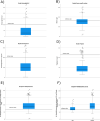Cluster-Analytic Identification of Clinically Meaningful Subtypes in MCAS: The Relevance of Heat and Cold
- PMID: 37029308
- PMCID: PMC10352424
- DOI: 10.1007/s10620-023-07921-5
Cluster-Analytic Identification of Clinically Meaningful Subtypes in MCAS: The Relevance of Heat and Cold
Abstract
Background: Mast cell activation syndrome (MCAS) is a clinically heterogeneous disease with allergy-like symptoms and abdominal complaints. Its etiology is only partially understood and it is often overlooked.
Aims: The aim of this study was to identify subgroups of MCAS patients to facilitate diagnosis and allow a personalized therapy.
Methods: Based on data from 250 MCAS patients, hierarchical and two-step cluster analyses as well as association analyses were performed. The data used included data from a MCAS checklist asking about symptoms and triggers and a set of diagnostically relevant laboratory parameters.
Results: Using a two-step cluster analysis, MCAS patients could be divided into three clusters. Physical trigger factors were particularly decisive for the classification as they showed remarkable differences between the three clusters. Cluster 1, labeled high responders, showed high values for the triggers heat and cold, whereas cluster 2, labeled intermediate responders, presented with high values for the trigger heat and low values for cold. The third cluster, labeled low responders, did not react to thermal triggers. The first two clusters showed more divers clinical symptoms especially with regard to dermatological and cardiological complaints. Subsequent association analyses revealed relationships between triggers and clinical complaints: Abdominal discomfort is mainly triggered by histamine consumption, dermatological discomfort by exercise, and neurological symptoms are related to physical exertion and periods of starvation. The reasons for the occurrence of cardiological complaints are manifold and triggers for respiratory complaints still need better identification.
Conclusion: Our study identified three distinct clusters on the basis of physical triggers, which also differ significantly in their clinical symptoms. A trigger-related classification can be helpful in clinical practice for diagnosis and therapy. Longitudinal studies should be conducted to further understand the relationship between triggers and symptoms.
Keywords: Cluster analysis; Food intolerance; Histamine; IBS; MCAS; Mast cell activation syndrome; Multisystemic complaints; SM; Systemic mastocytosis.
© 2023. The Author(s).
Conflict of interest statement
The authors declare that they have no financial or non-financial competing interests.
Figures




Similar articles
-
Health-related quality of life and health literacy in patients with systemic mastocytosis and mast cell activation syndrome.Orphanet J Rare Dis. 2022 Jul 29;17(1):295. doi: 10.1186/s13023-022-02439-x. Orphanet J Rare Dis. 2022. PMID: 35906626 Free PMC article.
-
Mast Cell Activation Syndrome and Gut Dysfunction: Diagnosis and Management.Curr Gastroenterol Rep. 2024 Apr;26(4):107-114. doi: 10.1007/s11894-024-00924-w. Epub 2024 Feb 14. Curr Gastroenterol Rep. 2024. PMID: 38353900 Review.
-
Idiopathic mast cell activation syndrome is more often suspected than diagnosed-A prospective real-life study.Allergy. 2022 Sep;77(9):2794-2802. doi: 10.1111/all.15304. Epub 2022 Apr 7. Allergy. 2022. PMID: 35364617
-
Mast cell activation syndrome: improved identification by combined determinations of serum tryptase and 24-hour urine 11β-prostaglandin2α.J Allergy Clin Immunol Pract. 2014 Nov-Dec;2(6):775-8. doi: 10.1016/j.jaip.2014.06.011. Epub 2014 Nov 6. J Allergy Clin Immunol Pract. 2014. PMID: 25439370
-
Using the Right Criteria for MCAS.Curr Allergy Asthma Rep. 2024 Feb;24(2):39-51. doi: 10.1007/s11882-024-01126-0. Epub 2024 Jan 20. Curr Allergy Asthma Rep. 2024. PMID: 38243020 Free PMC article. Review.
Cited by
-
Neuropsychiatric Manifestations of Mast Cell Activation Syndrome and Response to Mast-Cell-Directed Treatment: A Case Series.J Pers Med. 2023 Oct 31;13(11):1562. doi: 10.3390/jpm13111562. J Pers Med. 2023. PMID: 38003876 Free PMC article.
References
Publication types
MeSH terms
Substances
LinkOut - more resources
Full Text Sources

